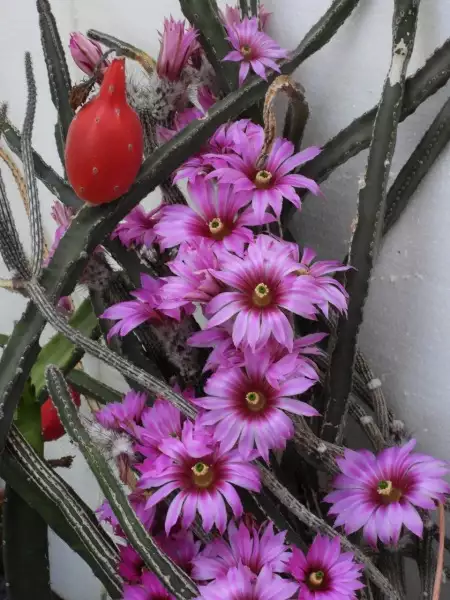Echinocereus poselgeri Peniocereus greggii Peniocereus diguettii 5/1/20
This is actually a very interesting picture. There are three species pictured.
The Echinocereus poselgeri plant is all the purply flowers These are the seed mates of the plant pictured earlier (#10).
The two red fruit are that of Peniocereus greggii, the Arizona Queen of the Night. You can't make them out, but there are several areoles on the P. greggii plant stems starting to form flower buds. Ah, there is one fuzzy right below the big red fruit. This is something you'll never see in nature, namely a P. greggii fruit on a budding stem. In nature, this species flowers around mid-June to mid-July. The fruit ripens about two months later and is eaten by something, probably before it's really ripe. Because the summer temperatures in Los Alamos (I live at 6400 feet) are significantly less than the habitat temperature of the species, my fruit took much longer to ripen. In fact, I moved the plants back into the greenhouse in the fall before the fruit was fully ripe. I picked a third fruit that split for some reason in December. I planted some of the seeds and got an amazing nearly 100% germination. The minute fuzzys on the stems have become obvious buds since the picture was taken, and two of them will bloom probably tomorrow night, with about ten more to come. The reason the plants are flowering at close to their natural calendar time is that they are still in the greenhouse. The greenhouse gets up to 115 F pretty much every day, so the P. greggii think they're home. (Present ambient highs are in the 80s. A 100 F daytime temp was rare when I first moved to Los Alamos. It's getting more common now. But we all know that global warming is a hoax. Our President says so and he never lies.)
The third species is Peniocereus diguettii. One of its stems is the diagonal crossing round thing. I collected the seeds xmas of 2004 while kayaking on the Sea of Cortez off Baja California, Mexico. I've since learned that the species grows around Tucson.
All three species are grafted onto a Harrisia rootstock because they all make a bunch of small potato-like things to an immense tuber (100+ lb for the P. greggii) and these potatoes/tubers make taking care of the natural plant very problematic. The tuber is the actual plant. The above-ground cacti are just the means that the tuber uses to harvest energy from the sun. (25/56)
<<Prev
Index
Next>>

